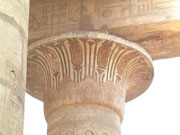TOUR NEWS - RAMESSES EGYPT NOVEMBER 2010
The B.C. Archaeology Tour of Egypt for November 2010 left Australia on the 11th November and ran until the 3rd December. The group included: Leslie Weisz, Dorothy Rowell, Lorna Crossett, Tara Ellam, Catherine Doherty, Nola Thompson, Margaret Weissman, Anne Cullen, Russell and Heather Howey, Kevin and Yvonne Want, Joel and Denise Magill, and Kelvin and Robyn Williams. The tour was led by me, Michael Birrell, and we were accompanied by our local Egyptian guide Mr Mohamed Aziz.
Our flight was on Singapore Airlines - the A380 was replaced by a smaller plane which I think made us all feel a little better, since there had been recent trouble with the engines. We had a short stopover in Singapore, and a second, briefer stop in Dubai. We arrived in Cairo early in the morning and we were lucky in that we were able to check into our rooms in Shepheards Hotel before venturing out. After freshening up we took a short drive to Saqqara where we saw the majestic Third Dynasty Step Pyramid of Djoser. We walked over to the Unas Pyramid complex and then explored the well preserved Old Kingdom mastaba tomb of Kagemni. Some members of the group descended into the burial chamber to see the Pyramid Texts of King Tety. In the afternoon we visited the ruins of Memphis where we saw the colossal statue of Ramesses the Great in the open-air museum.
On Saturday 13th November we went to Giza where we saw the Great Pyramid. We walked around this astonishing monument and then saw the superb cedar boat of Khufu. A short drive took us to the Pyramid of Menkaure where some of us climbed down into the burial chamber. A camel ride was experienced by Tara and Kevin before we explored Khafre�s impressive Valley Temple and saw the Sphinx close-up. Lunch took plcae at the Felfela Restaurant in Giza, specializing in Egyptian cuisine, before heading off to the Khan el-Khalili markets. This mediaeval market is a maze of shops and old mosques famous around the world for its jewellery and metalwork. Some of us explored the superb Islamic monuments in the area.
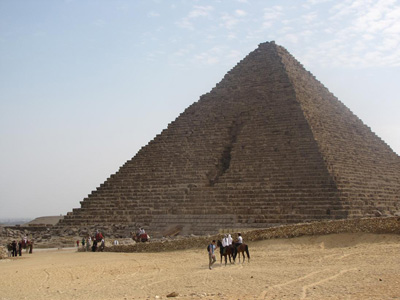 |
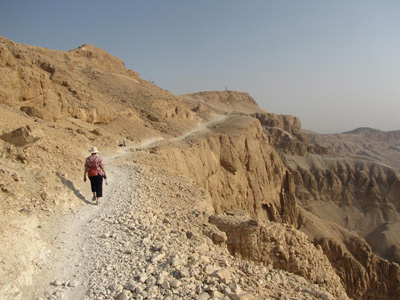 |
The pyramid of Menkaure |
Walking the Theban Hills |
The next morning we headed north to the Delta ruins of Bubastis, home to the cult of the cat god Bastet. Here we saw the ruined temple of the goddess and the statue of Merit-amun, daughter of Ramesses. We then headed to the famous Delta site of Tanis to see the ruins of the city. Numerous obelisks and statues of Ramesses II were brought here from the earlier capital of Per-Ramesses. A highlight of the site is the inscribed tombs of the Libyans Kings where the Tanis treasure was found. We then travelled to the nearby town of Ismailia on the Suez Canal where we stayed overnight in the Mercure Hotel. It was very pleasant to have a beer and water pipe down near the canal and watch the boats floating by.
The next day we drove from Ishmailia to Cairo. The day was set aside for the remarkable Cairo Museum with a guided tour concentrating on the sculptural remains. We saw the statues and reliefs of the 18th Dynasty and Ramesside Period including the treasures of Tutankhamun. We also saw the Tanis treasure. In the late afternoon we flew to Luxor and check into the Mercure Hotel, our base for a week�s exploration. On the morning of the 16th November we visited Luxor Temple, located in the heart of the modern city. We took our time to explore this world famous monument. After lunch in a caf� overlooking the temple we had some free time to rest and relax, or explore the markets. In the evening we visited Luxor Museum with its famous collection of New Kingdom sculpture - the Corniche Road along the Nile is getting a major makeover.
The following morning we walked across the Theban Hills, experiencing a spectacular view over the Nile Valley. Our walk took us from Deir el Medina to the famous mortuary temple of Queen Hatshepsut at Deir el Bahri - after a cold drink and ice cream we explored the superb temple, including the newly reconstructed Third Terrace. We had lunch in a local cafe before travelling by bus to the Valley of the Kings. Here we saw three of the royal tombs of the New Kingdom.
On the 18th November we stopped to see the Colossi of Memnon, two stunning seated statues of Amenhotep III from his mortuary temple and then went on to visit Deir el-Medina, the ancient village of the necropolis workmen. We explored the remains of the ancient village and saw the two superb painted tombs of Senedjem and Inherkau. The newly restored painted chambers in the Temple of Hathor are stunning. We then saw a number of the painted tombs belonging to high officials of the New Kingdom in the so-called �Valley of the Nobles�. This includes the tomb of Ramose, famous for its delicate carved relief. We had lunch in a nearby caf� and spent the afternoon at the romantic ruins of the Mortuary Temple of Ramesses II, also known as the Ramesseum.
The next day was set aside for rest and relaxation. Many of our group went for a balloon ride over the Theban Hills - I was very happy to spend a day reading my book and went for a felucca ride. The following day, the 20th November, we headed north from Luxor by bus to see the temples of Sety I and Ramesses II at Abydos. These superb painted temples contain beautiful wall reliefs and we had the place almost to ourselves (apart from the religious fruitcakes who were chanting in some of the shrines!). We had a walk across the desert to the Osireon, mythological tomb of Osiris, and explored the small Temple of Ramesses II. After a picnic lunch we headed back to Luxor, stopping en route to see the impressive Ptolemaic Temple of Hathor at Dendera and wander around the ruins. The recent cleaning of the roof has revealed stunning painted scenes and texts which were barely visible in the past. In the evening we headed over to the Amun Gezira Hotel to celebrate the birthday of Catherine Doherty - the musical performance and birthday cake made it a very pleasant evening.
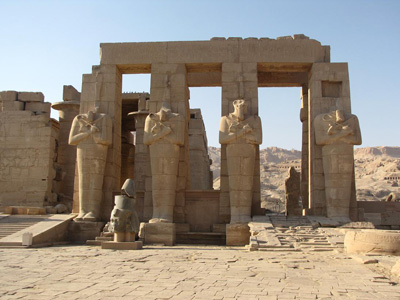 |
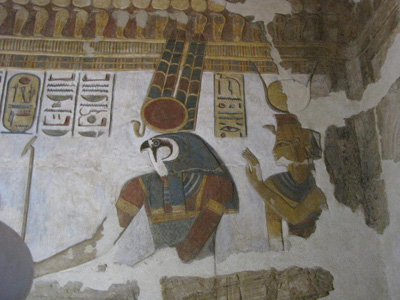 |
The splendid remains of the Ramesseum |
The restored scenes from the Temple of Khonsu at Karnak |
The following day was set aside to explore the ruins of the vast Temple of Karnak. We spent the morning looking at the forecourt and Hypostyle Hall, before wandering around the impressive granite shrine. We had a light lunch in the temple caf�. In the afternoon we saw the festival hall of Tuthmosis III, the Temple of Ptah and then explored the little-visited Ramesside Temple of the Moon God Khonsu. The newly cleaned reliefs from the rear chambers are stunning! Our last day in Luxor began with a visit to the temple of Medinet Habu, mortuary temple of Ramesses III. This building is famous for its superb war reliefs and coloured scenes of religious processions. We then visited the Valley of the Queens where we saw three royal tombs. In the afternoon we went for a felucca ride on the Nile - the wind unfortunately dropped away meaning that we had to be poled upstream and then floated back to the ferry place.
On the 23rd November we headed south from Luxor to Aswan. En route we made two stops - the first was to see the superb Ptolemaic temple of Horus at Edfu - we were there at the right time, since the tourists groups seemed to clear away and we were left to enjoy the place in peace. From here we continued on to Kom Ombo, home of the ruined temple of the crocodile god Sobek. We checked into the Marhaba Hotel, our base for a couple of days. The following morning we visited the painted tombs of the Old Kingdom governors of Aswan. We reached the cemetery by crossing the Nile by felucca sailboat and climbing the stairs to the tombs. The view across the Nile is magnificent and is even better from the Qubbet el-Hawa, the Dome of the Winds, on the summit of the hill - Dorothy, Anne and I made it to the summit for a 360 degree panorama. In the afternoon our boat took us to Kitchener�s Island where we toured the beautiful botanical gardens of Aswan. We had lunch (far too much food!) at the Nubian Restaurant located on a small island in the Nile. The view across the island of Elephantine is superb!
On the 25th November we visited the fascinating granite quarries of Aswan and saw the remarkable unfinished obelisk which is still embedded in the rock. Nola was a dab hand at working the granite using the ancient balls of dolerite. From here we went to see the Aswan High Dam, built in the 1960�s and 70�s to control the flooding of the Nile - the waters of lake Nasser glistened to the south. In the afternoon we headed by boat to Philae, cult place of Isis. This stunning complex is said by many to be Egypt�s most beautiful temple.
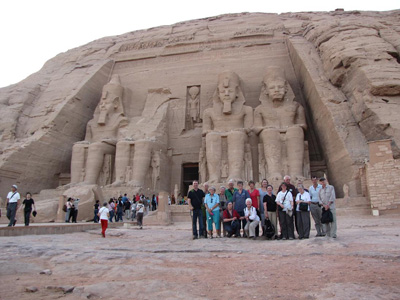 |
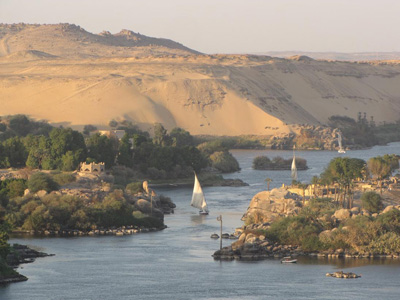 |
The group at Abu Simbel |
Sunset over the First Cataract - magic! |
The next morning we travelled by bus (3 hours) across the Nubian Desert to Abu Simbel, the most remarkable Nubian temples of Ramesses II and his wife Nefertari carved into the native rock of the hillside. These spectacular temples were moved during the building of the High Dam. We checked into our cruise boat, the Nubian Sea, had some lunch and then visited the temples of Abu Simbel. We had plenty of time to wander around the temples - many members of the group also went to experience the �Sound and Light Show� which is well worth seeing.
On the 27th November we departed Abu Simbel for our cruise on Lake Nasser, the view of the temples being spectacular in the early morning light. During the day we stopped to look at the ruins of Kasr Ibrim, a medieval town site, and later explored the romantic desert Temples of Amada (18th Dynasty) and Derr (Ramesses the Great). Both temples were moved during the 1960�s to protect them from the waters of Lake Nasser. The next morning we visited Wadi es-Sebua, constructed by Ramesses the Great. The temple is situated in a dramatic desert landscape and was moved when the Aswan Dam was built. The group took a camel ride across a vast desert landscape to see the ruins of the Temple of Dakka (Ptolemaic Period) and the Roman shrine of Maharakka. The afternoon was then spent cruising through a scenic landscape back to Aswan.
In the morning we saw the beautiful painted rock-cut temple of Ramesses II at Beit el-Wali, moved from its original location to a site near the Aswan High Dam. We also explored the Roman temple of Kalabsha dedicated to the Nubian god Mandulis and saw the near complete Kiosk of Qirtassi, re-erected with a view over Lake Nasser. In the afternoon we saw the Nubian Museum with its excellent collection of local artefacts, had a coffee overlooking the Nile and then headed to Aswan airport for our flight to Cairo. The final day of the guided tour was spent in the Old City of Cairo where we saw the well preserved buildings of the Islamic Period. High-lights included the monumental 19th Century Mosque of Mohamed Ali in the Citadel of Saladin and the impressive 14th Century Mosque of Sultan Hassan. The day ended with some shopping in the Khan el-Khalili markets. The 1st December was a free day - many members of the group re-visited the Cairo Museum. The following day we departed Cairo International Airport for our flight to Australia in the early afternoon with a stopover in Singapore.
Michael Birrell
